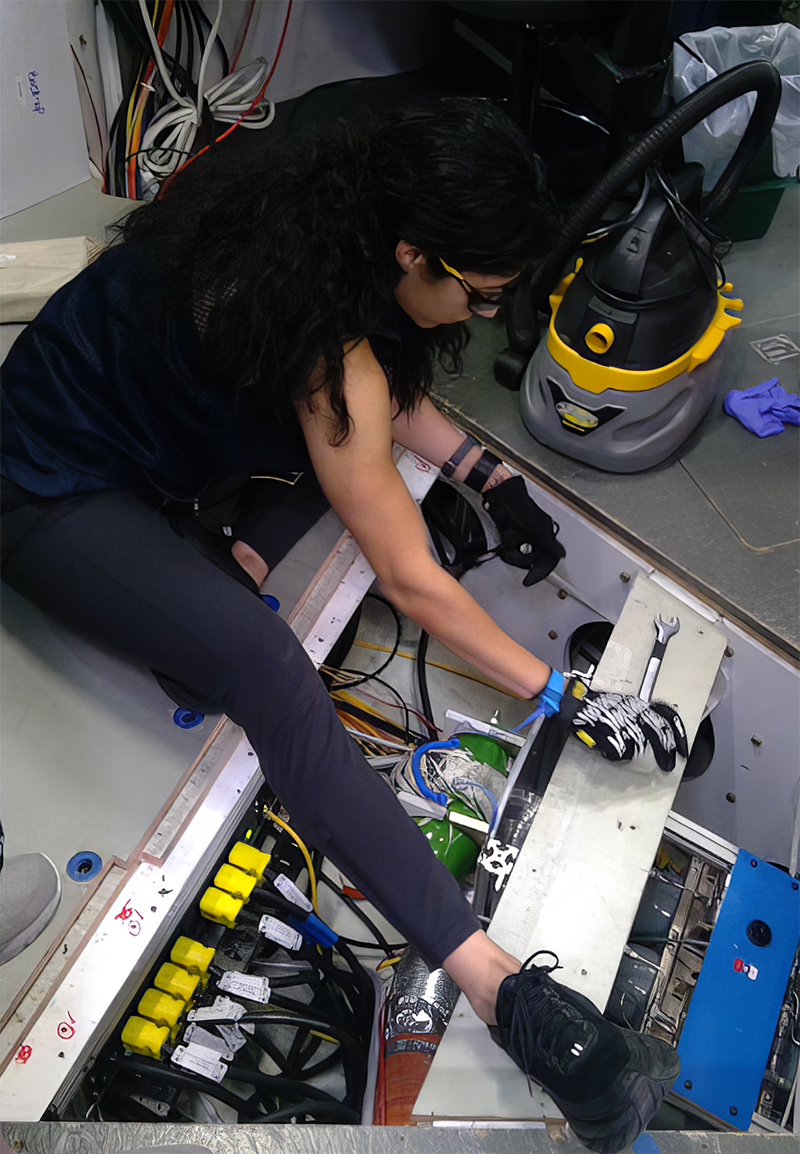It’s not unusual to see Embry-Riddle students wearing “Occupy Mars” T-shirts. Analog astronauts Christopher Roberts (’07) and Monique “Moxie” Garcia brought us closer to that reality by completing a journey to nowhere when they participated in NASA’s HERA Mission XXII, Campaign 6, a simulated flight to the Mars’ moon Phobos, which began Oct. 1, 2021, and ended Nov. 15, 2021.
As participants in NASA’s Human Exploration Research Analog (HERA) project, Roberts and Garcia spent 45 days in closely monitored isolation in a fake 650-foot spaceship parked at NASA’s Johnson Space Center in Houston. It simulated remote conditions and served as a human performance laboratory. NASA introduced the habitat in 2014 to simulate a variety of missions.

Roberts earned his master’s in Engineering Physics before joining NASA contractor HX5 in 2017. The support provided by his cold stowage team at HX5 to the International Space Station program earned him NASA’s Spaceflight Awareness Award in 2021 for outstanding contributions to flight safety and mission success.
Garcia is a human factors engineer for MITRE Corporation, where she originally focused on automation systems for U.S. Space Force satellites and user interfaces for NASA’s Deep Space Network. She was halfway through her master’s in Human Factors when military obligations for both Garcia and her husband, followed by the NASA mission, required her to pause her studies at Embry-Riddle and take a leave of absence from MITRE.
Their four-person mission also included Lauren Cornell, a researcher for the U.S. Air Force who holds a Ph.D. in Translational Science, and Madelyne Willis, a microbial ecologist with deployments to the Antarctic and Arctic.
What did they have in common? All are healthy, nonsmokers between 30 and 55, engaged in advanced science and curiosity as an extreme sport. All of the astronauts completed flight physicals and psychological testing. Before moving in with the three women who would become his unavoidable roommates for more than six weeks, Roberts says they got to know each other by playing cards and board games. They also collaborated on their mission patch.

According to Garcia, “Our specific crew did very well with cohesion. Our ideas for our patch represented all of us, not just with our four names but with six stars representing our two backup members. We included a rising phoenix because ours was the first group to come through after the COVID-19 lockdown.”
Ground(ed) Control
The crew stayed busy during 16-hour days, but they soon bonded as roommates who shared very limited space with almost nonexistent privacy. Board games remained part of their connection during “family time” when they relaxed at the end of the day. An avid cyclist, Roberts had to settle for a spin on a stationary bike wearing a smartwatch.
Roberts was away from his fiancé (now wife), and like the others, was restricted to a half-hour personal phone call each week.
However, he did get some additional “face time” with a wider audience, fielding questions during NASA groundlinks with students across the country.
They were alone — but someone was always watching. Mission control monitors HERA astronauts via video cameras and biometric trackers and sensors. Roberts admits that findings were not always shared because the astronauts themselves were test subjects. “We didn’t always get to know the results and measurements focused on our own health and performance.”
Garcia explains that based on expertise, people were assigned to lead specific research, but everyone did a little of everything. “If a device or system broke, I’d fix it. But everyone performed all the tasks for research purposes. That’s how you get that really well-rounded understanding of how each person can perform, especially with biometrics.”

Experiments aboard the mission were varied, from the exploration of triggers for latent viruses in the human body to hydroponic lettuce-growing to evaluations of long-term augmented reality. Often, the science focused more on the scientist. For example, to simulate repetitive, daily tasks that astronauts would undertake during deep-space missions, the crew raised brine shrimp. The performance and mindset of the crew gave NASA insight into potential strategies to optimize concentration and efficiencies for procedures required of future astronauts.
Garcia says they bonded to one shrimp that grew a little faster. “We assigned a gender — she — and a name, Shrimptelia. We monitored her a little closer than the rest. I think mission control got a kick out of our logs sometimes.”
Brine shrimp are not cuddly, but the team did have an emotional support animal of sorts, a shared teddy bear named Svetlana. Garcia explains, “They typically have a zero G indicator on a space flight. Our team went to an REI store the day before the mission and picked out an indicator/care bear. She became our tiny mascot.”
Re-Entry
For Roberts, enjoying a fresh salad was a priority after the mission. “We had nutritionally balanced meals, but you get tired of dehydrated camp food,” he says.
For Garcia, being under the sky again was the high point of her re-entry to the non-pod world, similar to the awe astronauts feel in space when seeing the Earth. “The air smelled so fresh, and the sky looked so bright and beautiful. That sounds cheesy, but I told the NASA psychologist that I wanted what they call an overview effect — typically something astronauts experience. I did get that, and it was profound for me.”
Lessons learned from HERA will help NASA ensure the safety of astronauts headed back to the Moon in 2024 and onto Mars. One day the T-shirt slogan will be a statement of fact, acknowledging a new outpost for humankind.
